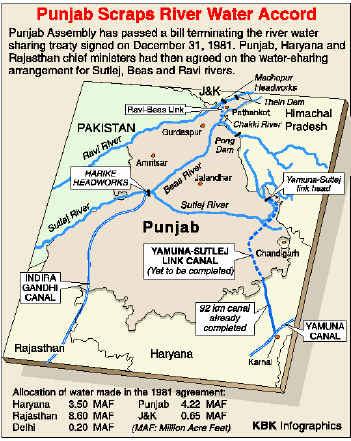Satluj Yamuna Link Canal
Supreme Court verdict on SYL canal was passed which said that it was unconstitutional for the Punjab state government to terminate a water sharing agreement with other states.

History behind the issue:
At an inter-state meeting convened by the central government in 1955, the total water of the Ravi and Beas — 15.85 million acre feet (MAF) — had been divided among Rajasthan (8 MAF), undivided Punjab (7.20 MAF) and Jammu and Kashmir (0.65 MAF).
The creation of Haryana from the undivided Punjab in 1966 began the problem of giving Haryana its share of river waters.
Punjab opposed to sharing waters of the Ravi and Beas with Haryana, citing riparian principles.
In March 1976, a decade after the Punjab Reorganisation Act was implemented, the Centre issued a notification allocating to Haryana 3.5 MAF out of undivided Punjab’s 7.2 MAF.
To enable Haryana to use its share of the waters of the Sutlej and its tributary Beas, a canal linking the Sutlej with the Yamuna, cutting across the state, was planned.
In 1981, there was a tripartite agreement between Punjab, Haryana and Rajasthan which was negotiated by PM Indira Gandhi.
In 1982, the construction of the 214-km Sutlej-Yamuna Link (or SYL) canal began in which 122 km was in Punjab and 92 km in Haryana.
The available waters of Ravi and Beas were recalculated to be 17.17 MAF and the states were given revised water — Punjab (4.22 MAF), Haryana (3.5 MAF) and Rajasthan (8.6 MAF).
However, a political party- Akali Dal- opposed this agreement and started with Kapoori morcha to oppose the construction of the SYL canal.
In 1985, Punjab Accord was signed between PM Rajiv Gandhi and Akali Dal leader. In this, it was agreed that a tribunal would verify the claims of both Punjab and Haryana on river waters.
In 1987, the Eradi Tribunal headed by SC judge Eradi recommended an increase in the shares of Punjab (5 MAF) and Haryana (3.83 MAF), while taking into account utilisable supplies of surplus water at base stations.
Later developments:
The tribunal’s decision was not notified.
Meanwhile, Punjab experienced militancy in that period and continued reigning terror in process of canal construction by attacking senior canal staffers.
In 1990, Haryana requested central government to take up the issue with a central agency but it made no progress.
Finally, Supreme Court was approached in 1996 where it directed Punjab to complete the canal work. In 2002, SC ordered Punjab to complete the canal in a year.
In 2004, the Punjab Assembly passed The Punjab Termination of Agreements Act, 2004, terminating its 1981 water-sharing agreement, and thus jeopardising the construction of SYL in Punjab, just after SC directed it to form ‘central agency’ to complete canal work.
Apprehending trouble, then President A.P.J Kalam sought the Supreme Court’s opinion on the 2004 Act under Article 143 (1) of the Constitution.
Art 143 confers in the President of India the power to consult Supreme Court at any time it appears to the President that a question of law or fact has arisen, or is likely to arise, which is of such a nature and of such public importance that it is expedient to obtain the opinion of the Supreme Court upon it.
It is discretionary for the Supreme Court to answer or not to answer the questions put to it under Art 143 (1) but it is bound to give advice if it comes under Art 143 (2).
Punjab’s legislative adventurism and impact
There was no doubt that Punjab Termination of Agreements Act, 2004 would not have survived judicial scrutiny as it defaulted the 1981 agreement.
The SC has given reasons from previous verdicts relating to the Cauvery and Mullaperiyar disputes by reiterating the principle ‘a State cannot, through legislation, do an act in conflict with the judgment of the highest court which has attained finality’.
The verdict re-imposes the fact that it would be destructive of the rule of law and federalism if a State were to be allowed to overpower judicial powers by nullifying a verdict that is based both on fact and law.
Such disputes on water issues creates a competition among major political parties on who among them is the best protector of the State’s interests.
This attitude leads to creation of a disturbing tendency among States to be judges in their own cause, especially in water issues.
It has recently been regularly observed that political parties have resorted to legislations or assembly resolutions rather than negotiations. Even the opposition parties collaborate in such issues with equal zest so that they are also visible in support of the cause.
Hence, now is the need to take up the path of negotiation and conciliation and not take actions unilaterally where more than one state is involved.
85% of the canal work is already completed in the Satluj Yamuna Link Canal. Just as Haryana can get access to waters of Satluj river, even Punjab can get access to Yamuna waters. The states have to talk, negotiate and decide mutually and not abrogate agreements. It is a fact that India’s experiments with water imports through canals have not always been successful. But in the era of climate change, when India faces drought and flood challenges in same year, it requires the solution to long pending demand of connecting rivers.


